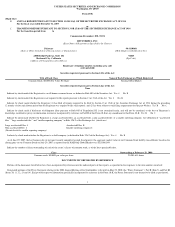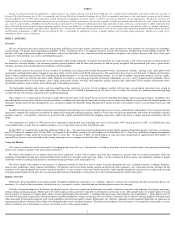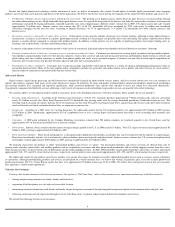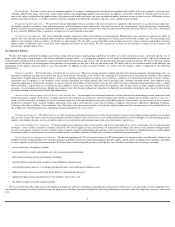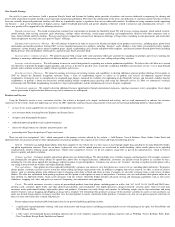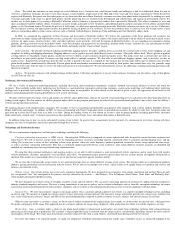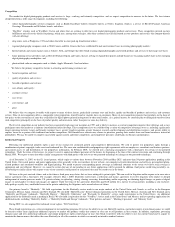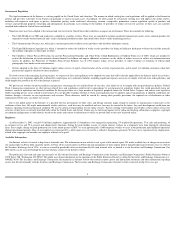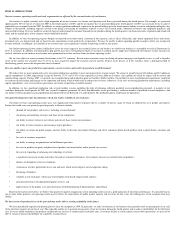Shutterfly 2008 Annual Report Download - page 5
Download and view the complete annual report
Please find page 5 of the 2008 Shutterfly annual report below. You can navigate through the pages in the report by either clicking on the pages listed below, or by using the keyword search tool below to find specific information within the annual report.
Internet and digital photo-
based technology enables consumers to create an archive of memories that extends beyond photos to include highly personalized, more engaging
products and services that can be protected and preserved for future generations. We believe that the key forces driving the expansion of the market for these products and services are:
Addressable Markets
Digital cameras, digital image processing and the Internet have dramatically changed the photo-
related services market, and have created entirely new ways for consumers to
capture, edit, enhance, organize, find, share, create, print and preserve images. In particular, the range and quality of printed photos, photo-based products, photo-
based merchandise
and ancillary products have expanded and improved significantly, while associated production costs and the time required to create this output have decreased dramatically.
Consequently, companies like Shutterfly are now addressing a wide variety of consumer needs and multiple, large markets in ways not possible with earlier technology.
We currently address several adjacent markets related to consumers’ desire to be thoughtful and creative with their memories. These include, but are not limited to:
We generally characterize our products as either “personalized products and services” or “prints”.
Our personalized products and services revenues are derived from sales of
greeting cards, calendars, photo books, and ancillary products such as scrapbooking accessories and other photo-
based merchandise, and the related shipping revenue from these sales,
while our print revenues are derived from sales of photo prints and the related shipping revenue. In 2007, 2006 and 2005, our personalized products and services revenues represented
approximately 56%, 51% and 42% of our total net revenues, respectively, and our print revenues represented approximately 44%, 49% and 58% of our total net revenues, respectively.
The addressable market for our products and services includes every person who enjoys the memories created by digital photographic devices such as cameras, camera cell phones
or camcorders. Although photofinishing products and services are purchased by a broad consumer base, we believe that women, in particular, play a key role in many photo-
based
purchasing decisions. The U.S. Census Bureau reports that there were approximately 55 million women age 25-
44 in 2006. We believe that securing the loyalty of this core consumer
base represents a sizable market opportunity.
Value for Our Customers
Creating value for our customers is the basis for our success. Our tag line is “Tell Your Story,” and we offer customers easy, convenient and fun ways to tell their stories by:
We provide the following benefits to our customers:
•
Proliferation of digital cameras and penetration of
high-speed connectivity.
The growing use of digital cameras, largely driven by price decreases, has increased the demand
for online photo-printing services. High-bandwidth, high-
speed Internet access has spurred the integration of the Internet into daily life and provides consumers with improved
performance and speed for sharing information, especially large files sizes such as digital images. Industry sources estimate that in 2007, U.S. digital camera unit sales reached
approximately 25 million units. Industry sources also estimate that 70% of all U.S. households will have broadband by 2012, with nearly 36 million new broadband
subscribers emerging over the next five years. According to Industry Resources, 61.7% or approximately 71.4 million U.S. households have both a digital camera(s) and
Internet access.
•
Increasing convenience and quality of online photo
services. Online photo services provide multiple advantages over at-home printing. Although at-
home photo printing is
instantaneous, it requires an investment in a printer, photo paper and ink, resulting in a much higher cost per print and is time consuming. The quality rendered from at-
home
printers is usually inferior compared to commercially produced prints. In addition, at-
home printers are less capable of producing products that require binding and / or
finishing, such as photo books, calendars and folded greeting cards.
In contrast, online photo services conveniently provide a wide variety of customized, high
-
quality photo
-
based products delivered directly to consumers
’
doorsteps.
•
Growing consumer desire to find easy, convenient ways to generate personalized content. Consumers are interested in creating highly customized and personalized photo-
based products and merchandise to preserve their precious memories, express their creativity and make gift giving more personal and thoughtful. Improvements in software and
photo editing tools have enabled consumers to modify their photos quickly and easily using a personal computer. Consumers are now able to create digital compilations of
memories that were previously only possible through a physical and more time
-
consuming process.
•
Participation in online communities.
Consumers have become increasingly comfortable with using the Internet as a forum for sharing and publishing information in open or
permission-based networks. Many of the most popular online communities include user-generated, rich-media content such as photos and videos because of visual content’
s
inherent ability to communicate more powerfully than the written word.
•
Greeting cards and stationery. According to the Greeting Card Association’
s website, U.S. consumers purchase approximately 7 billion greeting cards each year, generating
nearly $7.5 billion in retail sales. More than 90 percent of all U.S. households buy greeting cards, with the average household purchasing 30 individual cards per year. The
Greeting Card Association also reports that nine out of ten Americans say they look forward to receiving personal letters and greeting cards because cards allow them to keep in
touch with friends and family and make them feel they are important to someone else.
•
Scrapbooks.
According to a 2007 survey by Creating Keepsakes, the addressable markets for the US scrapbook industry was approximately $2.87 billion in 2007 up from
$2.55 billion in 2004. Additionally, approximately 82% of scrapbookers have at least a college degree and spend almost four hours a week assembling their memories into
scrapbooks.
•
Calendars.
A 2002 guide published by the Calendar Marketing Association estimated that 500 million calendars are produced annually in the United States and that
approximately 98% of American households have at least one calendar.
•
Photo prints
. Industry sources estimate that the number of digital images printed in the U.S. in 2006 reached 15 billion. Total U.S. digital revenue reached approximately $9
billion in 2007, growing to approximately $12 billion in 2011.
•
Photo
-based merchandise. Photo-
based merchandise is a substantial market opportunity that includes any product that can be customized with the imprint of a digital image.
Photo-based merchandise includes, but is not limited to, photo calendars, photo greeting cards and photo books. Industry sources estimate that U.S. revenue from photo-
based
merchandise reached approximately $560 million in 2007, growing to approximately $1.5 billion in 2012.
•
sharing and preserving memories for family, friends and themselves;
•
organizing all of their photos in a safe and easily accessible location;
•
maintaining emotional connections with friends and family, despite being time
-
constrained, through thoughtful and personal photo
-
based communications and gifts; and
•
achieving satisfaction and self
-
expression through creativity and telling stories via photos and personalized photo
-
based products and services.
4


